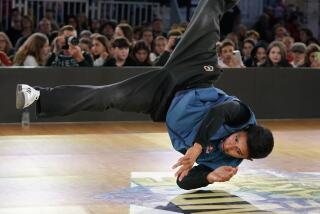Appeal of the X Games Is a Growth Enterprise
There was a time when the NBA wasnât the lucrative, money-churning, mainstream media behemoth it is today. It was a regional game, marooned in the Midwest and struggling on the East Coast some 40 years ago, failing to register more than a blurb in newspapers, lagging behind the headlines given to baseball and football.
Players didnât leave early from college. There were no sneaker endorsement deals. National interest in the sport was marginal.
Then came the â80s, Magic Johnson and Larry Bird followed by Michael Jordan, and the rest is NBA history -- an explosion into mainstream media and culture, the latest examples a $4.6-billion price tag for the NBAâs TV broadcast rights and a $90-million shoe deal for wunderkind LeBron James.
When the X Games began nine years ago, they were essentially a band of tattooed skateboarders running around in baggy shorts and having water-balloon fights at the dorms in which they were housed at a small Catholic college in Newport, R.I.
The rest of the nation barely noticed. Or cared.
But what began as the brainchild of an ESPN accountant has turned into a moneymaking entity with big-name sponsors that dole out millions for a chance to persuade Americaâs youth how cool it is to drink Mountain Dew.
Donât fool yourself: Skateboard terms such as âswitch pop shove-itâ and âbackside 180 fakie nosegrindâ arenât exactly cropping up in coffee-shop chatter.
But the X Games, which run Thursday through Sunday and have events at Staples Center and the Coliseum, have drifted more and more into mainstream culture and media.
The original creator of the X Games, Ron Semiao, didnât use complex formulas or confusing numbers to measure the popularity of action, or âextreme,â sports. His favorite argument for their success? The Nickelodeon Kidsâ Choice Awards.
Shaquille OâNeal, Tiger Woods and Kobe Bryant were on last Aprilâs ballot. The landslide winner was the other guy on the ballot -- Tony Hawk.
âKids look at the best skateboarder and [extreme motocross] people in the same regard and admiration that they look at any athlete,â said Semiao, now a senior vice president at ESPN. â[X Games] is not as popular as the NBA Finals, but when they measure the pro athletes, people like [skateboarders] Tony Hawk and Bob Burnquist are on the same level as Barry Bonds and Shaq.â
X Games resonates with the younger generation, even when looking at statistics more important than kidsâ awards shows.
The all-important demographic of 12- to 24-year-old males increases by 50% during the four-day run of the annual X Games, said Mark Shapiro, ESPNâs vice president of programming and production.
ESPN, looking to tap into the surge in young viewers, will use this yearâs X Games to kick-start NFL programming for the upcoming season and to pitch its first scripted dramatic series, âPlaymakers.â
âOur [audience] gets younger than it ever is that weekend,â Shapiro said.
Younger and, corporate America hopes, more impressionable.
About 15 big-name sponsors -- Sonyâs PlayStation2, PepsiCoâs Mountain Dew and AT&T;, to name a few -- have bought advertising packages reportedly worth between $1.5 million and $3 million. Depending on the investment, sponsors receive commercials, on-site signage and cross-promotion in ESPNâs other media outlets -- its magazine and radio network.
The return on the investment is as simple as 9-year-old Johnny digging into his pocket to buy a can of soda or as complex as a 16-year-old asking mom and dad if he can have a Saturn as his first car.
âThey are the hardest generation to reach and in a self-created franchise, ESPN has been able to dip into that,â said Paul Swangard of the Warsaw Sports Marketing Center at the University of Oregon. âI think if you strip away the sport itself, what it really reflects is a wonderful target audience theyâve been able to find a way to attract.â
Attract, yes. But the big question is whether the X Games can keep their audience over time. Will todayâs teens still idolize skater Eric Koston and biker Dave Mirra 20 years from now? Truly mainstream sports have the ability to tap into multiple demographics, not only one, and can retain such audiences over time.
âIf we want to view X Games in the same vein as the NFL and other sports, thereâs that ultimate litmus test: Is there that 40-year-old guy out there thatâs still a fan?â Swangard said.
ESPN doesnât seem concerned. Some executives claim that extreme sports were launched to appeal to a niche group of fans, not to convert older fans that favor traditional sports.
The view through ESPNâs rose-colored glasses is something like this: Teens fall in love with extreme sports, continue to be fans as they transition into their 20s and are replaced by a new wave of teens who enjoy extreme sports as much as or even more than the previous cycle of teens.
âThe natural evolution of time grows the fan base and keeps the industry going and the X Games healthy,â Semiao said.
Action sports athletes and fans, some of them anti-establishment in nature, arenât necessarily in favor of catching the mainstream wave. To some, there are fewer things worse than being overrun by high ticket prices, on-site sushi stands and, gag, luxury suites.
World-renowned Norwegian snowboarder Terje Haakonsen refused to compete in last yearâs Winter Olympics because he felt the sport had become too mainstream, a testimony to an overarching concept among action sports athletes.
They are definitely individualists.
In many of their sports, the non-competitive nature is overwhelming. There are no coaches, chalk talks, training tables or practices.
There are no penalties for arriving late at the skate park, no fines for showing up overweight at an in-line skating competition.
âThere are those who participate in skateboarding and [freestyle motocross] who like to be in competitive events but there are even more who like to learn at their own pace and not necessarily compete with anything other than themselves,â X Games General Manager Chris Stiepock said. âThe lack of infrastructure is something that initially draws a kid to these sports but is something that may keep these sports from being as big as the NFL and NBA.â
Signs point, however, to an inevitable thrust toward bigger and better.
Geographically, the X Games have gradually moved from small-market venues to larger and larger cities.
The X Games began in 1995 in Rhode Island and climbed the ladder of populous cities, moving from San Diego to San Francisco to Philadelphia, never staying more than their customary two years at each place.
The X Gamesâ choice of Los Angeles over Miami as host for the next two years silenced industry critics who felt L.A., a natural hotbed of action sports and the home of many industry sponsors, had been getting snubbed.
âI think five or six years ago we might not have been ready for L.A.,â Stiepock said. âI donât think we were a big enough property to resonate in the L.A. area and get the attention that you really need to be able to garner a crowd in Los Angeles.
âHaving been through San Francisco and Philly on our way to L.A., we felt like we were ready. We felt like L.A. was the epicenter for action sports. In that sense the X Games belongs there.â
It will be the latest test of the X Gamesâ mainstream strength.
âFor at least 10 more years thereâs a really good avenue for something like the X Games,â said editor Kurt Roy of TransWorld media, the leading action sports publisher.
âIf itâs all about money, youâd be better going off with team sports. But the culture and the lifestyle canât really be competed with. There wonât be any slowing.â
More to Read
Go beyond the scoreboard
Get the latest on L.A.'s teams in the daily Sports Report newsletter.
You may occasionally receive promotional content from the Los Angeles Times.











